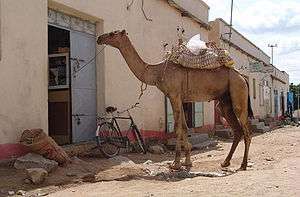Gash-Barka Region
| Gash-Barka Zone Zoba Gash-Barka | |
|---|---|
| Zoba | |
 Gash-Barka Region in Eritrea | |
| Coordinates: 15°15′N 37°30′E / 15.250°N 37.500°ECoordinates: 15°15′N 37°30′E / 15.250°N 37.500°E | |
| Country | Eritrea |
| Capital | Barentu |
| Government | |
| • Administrator | Musa Raba |
| Area | |
| • Total | 33,200 km2 (12,800 sq mi) |
| Population | |
| • Total | 1,103,742 |
| • Density | 33/km2 (86/sq mi) |
| ISO 3166 code | ER-GB |
Gash-Barka (Tigrinya: ጋሽ-ባርካ?) is one of the six regions of Eritrea. It is situated in the south-west of the country, bordering the Anseba region to the north, and the Maekel (Central) and Debub (Southern) regions to the east; the country of Sudan lies to the west and Ethiopia to the south.
The capital of Gash-barka is Barentu. Other towns include Agordat (the former capital), Molki, Sebderat and Teseney.

With an area of 37,000 square kilometers and a population of 567,000, the Gash Barka region makes up roughly one-third of Eritrea. Many call this region the "breadbasket" as the region is rich in agriculture. As of 2005, many believe there are over 3.5 million livestock in this region, and many camels. The region is also rich in marble, and other important minerals, including gold. In Augaro, there are some old mineshafts and machinery from the days when the Italians mined gold here.
Most of the people in the area tend to be healthy and well-fed, a rarity in this area of Africa.
The region also includes the following districts:


- Agordat City
- Barentu City
- Dghe
- Forto
- Gogne
- Haykota
- Logo Anseba
- Mensura
- Mogolo
- Molki
- Omhajer (Guluj)
- Shambuko
- Tesseney
- Upper Gash
Crops and Exports
Flora and fauna
Within the entire country there existed extensive forestation as recently as 1900 AD; however, there is less than one percent forested area present in the country,[1] and this deforestation trend has been mirrored in the region. Most of Eritrea was previously habitat for the endangered painted hunting dog, Lycaon pictus; however, this canid is now deemed extirpated from Gash-Barka and all of Eritrea due to the expanding human population in this country.[2]
References
Sources
- Edward Denison and Edward Paice. 2007. Eritrea, fourth edition, Published by Bradt Travel Guides, 224 pages ISBN 1-84162-171-4, ISBN 978-1-84162-171-5
- C. Michael Hogan. 2009. Painted Hunting Dog: Lycaon pictus, GlobalTwitcher.com, ed. N. Stromberg
- GeoHive global statistics
